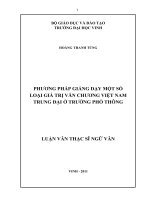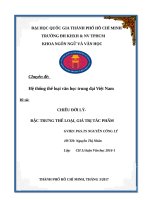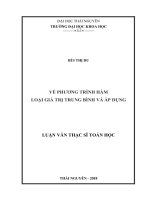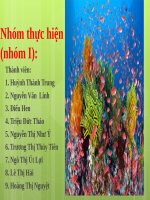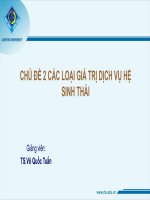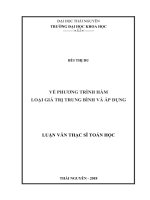Ảnh hưởng của tính tôn giáo đối với hệ tư tưởng chính trị thông qua các loại giá trị và đặc điểm tính cách một so sánh giữa thổ nhĩ kỳ và hoa kỳ
Bạn đang xem bản rút gọn của tài liệu. Xem và tải ngay bản đầy đủ của tài liệu tại đây (152.12 KB, 6 trang )
Available online at www.sciencedirect.com
Procedia Social and Behavioral Sciences 5 (2010) 12–17
WCPCG-2010
The effect of religiosity on political ideology via value types and
personality traits:
A comparison between Turkey and USA
Özlem Dirilen-Gümüúa *
a
Atilim University, Department of Psychology, Ankara 06836, Turkey
Received January 14, 2010; revised February 6, 2010; accepted March 29, 2010
Abstract
In this study, the relationships between religiosity, values, personality and political ideology were investigated across two
different cultures: Turkish and American. Participants completed Portrait Values Questionnaire, Big Five Inventory, Religiosity
Scale and Political Ideology Scale together with some demographics. Based on the findings, it was concluded that, religiosity
influences political ideology indirectly (also directly) via their influence on value structure in both individualist and collectivist
cultures, then this value structure inarguably creates a propensity toward endorsing certain political ideologies. The findings were
discussed in the light of relevant literature and possible impacts on psychological functioning of individuals.
© 2010 Elsevier Ltd. Open access under CC BY-NC-ND license.
Keywords: Religiosity, values, personality, political ideology.
1. Introduction
In this study, the relationships between four basic concepts, which are religiosity, value types, personality traits
and political ideology were investigated across two different cultures: a collectivist (Turkish) and an individualist
(American) culture.
1.1. Religiosity
Religiosity is defined as society-based beliefs and practices relating to a higher power, which are commonly
related to a church or an organized group (Peterman, Fitchett, Brady, Hernandez, & Cella, 2002; Erdem, 2010).
James (1902) described two kinds of religious experience where more modern conceptualizations of religious
orientation are originated from. In 1950, Allport characterized these kinds of religious behaviour as ‘‘Extrinsic” and
‘‘Intrinsic” religious orientations. People who view religion as an end in itself and as central to his or her identity are
considered as intrinsically oriented, whereas others who tend to see religion as a means to other ends is considered
as extrinsically oriented (Allport & Ross, 1967). Intrinsically oriented individuals accept the values of that religion
more, and they have more tolerance for the different groups and oppositional ideas. On the other hand, people who
* Özlem Dirilen-Gümüú. Tel.: +90-312-586-8426; fax: +90-312-586-8091.
E-mail address:
1877-0428 © 2010 Published by Elsevier Ltd. Open access under CC BY-NC-ND license.
doi:10.1016/j.sbspro.2010.07.042
Özlem Dirilen-Gümüs¸ / Procedia Social and Behavioral Sciences 5 (2010) 12–17
13
have extrinsic orientation value the social and economic outcomes of being the member of that religious
organization than the religion itself. In this study, religiosity is operationalized as the person’s general subjective
evaluation of his religiosity level.
1.2. Values
Values are defined by Schwartz (1992) as desirable, transsituational goals, varying in importance, that serve as
guiding principles in peoples’ lives. The model includes a set of 10 motivationally distinct types of values; namely;
power, achievement, stimulation, self-direction, hedonism, universalism, benevolence, conformity, security and
tradition. This constitutes a set of core values recognized in cultures around the world. This set of the 10 types
probably does not exclude any significant basic value types and disposes a near-universal structure of relations
among the 10 value types (beyond the differences in terms of different groups’ and individuals’ value priorities).
1.3. Personality
Personality traits are enduring characteristics of the individual that summarize trans-situational consistencies in
characteristic styles of responding to the environment (Costa & McCrae, 1992; Goldberg, 1993). Guilford (1959)
argued that personality refers to the individual’s “unique pattern of traits” (p.5), and a trait is “any distinguishable,
relatively enduring was in which one individual differs from others” (p.6).
A developing body of evidence indicates that personality traits are strongly heritable (Jang, McCrae, Angleitner,
Riemann, & Livesley, 1998), immune to parental and social influences (Asendorpf & Wilpers, 1998), and stable
throughout adulthood (McCrae & Costa, 1990).
The Five-Factor Model, a dimensional representation of personality structure referring to Extraversion,
Agreeableness, Conscientiousness, Neuroticism and Openness to Experience, gradually gained acceptance among
personality theorists as a general framework (Digman, 1990; Mervielde & Vandierendonck, 1994). The five-factor
structure even transcends species (Jang et al., 1998).
1.4. Political Ideology
In the past, researchers often assumed that both political parties and political attitudes could be displayed on a
single left-right dimension (McClosky, 1958). However, more recently it has been argued that the meaning of the
left–right dimension varies across nations and over time. Therefore, the single dimension approach is insufficient to
represent the relevant political dimensions in a given society (Inglehart, 1990). Eysenck (1954) added one more
dimension which is tough-mindedness and tender-mindedness which is also known as moderate and extreme forms
of left and right.
1.5. Relationships among Religiosity, Values, Personality and Political Ideology
Many studies were conducted to understand the relationships among these concepts. First, the relation between
religiosity and Schwartz’s values was first studied by Schwartz and Huismans (1995). This study showed that
religion was positively associated with tradition and conformity and negatively associated with hedonism,
stimulation, and self-direction. Second, Saroglou (2002) conducted the first meta-analysis of the relationships
between religion and the Big Five personality factors. Saroglou concluded that the strongest and most consistent
predictors were agreeableness and conscientiousness. Values and personality were also found to predict religiosity,
but, there is a controversy in theory about which of the two better predict religiousness: Are people attached to
religion primarily because (a) they are agreeable and conscientious or (b) because they value social order, tradition,
and benevolence, and they disvalue autonomy and hedonism? If we reverse the causal direction, does being or
becoming religious have an impact (a) on personality itself or (b) on the importance of specific values? This study
aims to clarify the difference between values and personality (Saroglou & Munoz-Garcia, 2008). Third, the
relationship between religiosity, values and political ideology were investigated (Schwartz & Huismans, 1995). It is
found out that, religions influence political attitudes via values because religious teachings stress the importance of
some values and degrade the importance of others, and, in this way, shape their members’ value system (Duriez,
14
Ưzlem Dirilen-Gümüs¸ / Procedia Social and Behavioral Sciences 5 (2010) 12–17
Luyten, Snauwaert, & Hutsebaut, 2002). This study adds personality as a mediating variable between the
relationship of religiosity and political ideology since the theoretical explanations did not reveal the difference
between values and personality as mediators of this relationship.
As a result, it was hypothesized that religiosity would have an effect on political ideology; however, this effect
was hypothesized to be mediated by values and personality traits. Besides, the pattern of these relationships was
expected to vary from culture to culture. Especially, the broadest differences were to be evidenced between
individualist and collectivist cultures since the basic dynamics of these cultures are substantially different. In line
with these hypotheses; two mediation models were tested for Turkish and American samples.
2. Method
2.1. Participants
Three hundred and eighty-two Turkish and 386 American participants took part in the study. The American
sample was largely composed of European Americans (76.3%), and the majority of two samples were undergraduate
students. The average age of the Turkish sample was 21.74 and American Sample was 22.75.
2.2. Instruments
Participants completed Portrait Values Questionnaire (PVQ), Big Five Inventory (BFI), Religiosity Scale and
Political Ideology Scale together with some demographics.
2.2.1. Portrait Values Questionnaire (PVQ)
A more recently developed measure of values, Portrait Values Questionairre (Schwartz, Melech, Lehmann,
Burgess, Harris, & Owens, 2001) has been developed to overcome difficulties that respondents experience in
responding to SVS. PVQ is composed of 40 two-sentence items, each describing a person with respect to his/her
goals, aspirations, or wishes. On 6-point scales, respondents are asked to indicate to what extent the depicted person
on each item is similar to themselves.
2.2.2. Big Five Inventory (BFI)
The BFI, constructed by John, Donahue, and Kentle (1991), uses short phrases to assess the most prototypical
traits associated with each of the Big Five dimensions. The trait adjectives (e.g., thorough) that form the core of
each of the 44 BFI items have been shown in previous studies to be markers of the Big Five dimensions (BenetMartinez & John, 1998). The 44-item BFI was developed to represent the prototype definitions developed through
expert ratings and subsequent factor analytic verification in observer personality ratings. Participants rate each BFI
item on a 5-point scale ranging from 1 (disagree strongly) to 5 (agree strongly); scale scores are computed as the
participant's mean item response ( i.e., adding all items scored on a scale and dividing by the number of items on the
scale) (Benet-Martinez & John, 1998).
2.2.3. Religiosity Scale
Respondents reported their subjective religiosity on a 1 (strongly disagree) to 7-point (strongly agree) scale in
response to the item, “My religion is very important for me”. The item focused on the nature of participants' beliefs
about their strength of religious beliefs (Schwartz & Huismans, 1995).
2.2.4. Political Ideology Scale
We measured political ideology with a left-right placement item. We used the following statement: “Please
indicate your political ideology by putting an X sign below your choice”: 1-Extreme Left, 2-Moderate left, 3Moderate right, 4-Extreme right, 5- No preference and 6-Other (5 and 6 are treated as missing values). We excluded
from the analysis 101 Turkish and 108 American respondents who chose either “no preference” or other and who
failed to report their political orientation. The mean response for Turkish sample was 2.44 (SD = .80) and for
American sample was 2.21 (SD = .74).
15
Ưzlem Dirilen-Gümüs¸ / Procedia Social and Behavioral Sciences 5 (2010) 12–17
2.3. Procedure
The participants were administered the questionnaires (containing measures of each variable and demographic
information) by the author in group sessions containing up to 25 individuals. The American sample completed the
questionnaire either in their department computer labs (special permission taken from IRB) or via an on-line survey
service. Informed consent of the participants was taken and confidentiality of responses was assured.
3. Results
It was hypothesized that religiosity would have an effect on political ideology; however, this effect was
hypothesized to be mediated by values but not by personality traits. Besides, the pattern of these relationships was
expected to vary from culture to culture. Especially, the broadest differences were to be evidenced between
individualist and collectivist cultures since the basic dynamics of these cultures are substantially different.
In line with these hypotheses; two mediation models were tested for Turkish and American samples. The first
model was hypothesized the relationships among religiosity, values, personality and political ideology for Turkish
case. Both direct and indirect (mediated) effects were examined. The reduced model is shown in Figure 1. The
results have shown that, the relationship between religiosity and Tradition was significant with a standardized
regression coefficient of .41. The relationship between Tradition and political ideology was significant with a
standardized coefficient of .25. Similarly, the relationship between religiosity and political ideology was significant
with standardized coefficient of .50. All other relationships in the model were not significant. There is both direct
and indirect effect of religiosity on political ideology and the relationship was mediated by tradition. The SOBEL
test was conducted using a SOBEL calculator (Preacher & Leonardelli, 2003) to confirm mediation effects. The
guidelines provided by Preacher and Leonardelli (2003) were used to calculate the SOBEL test statistic. The
SOBEL test statistic for the mediating effect of tradition on religiosity and political ideology was 3.56, which was
found to be significant (p<.001). This suggested that tradition mediated the relationship between religiosity and
political ideology. The total indirect effect of religiosity on political ideology is plus .10 (.41 * .25). In comparison,
the direct effect is plus .50. The total causal effect of religiosity on political ideology is (.10 + .50) = .60.
.41
Religiosity
.25
Tradition
Political Ideology
(Left to Right)
.50
Figure 1. Reduced PARTIAL mediation model for Turkish sample
The second model was hypothesized the relationships among religiosity, values, personality and political
ideology for American case. Both direct and indirect (mediated) effects were examined. The reduced model is
shown in Figure 2. The results have shown that, the relationship between religiosity and Tradition was significant
with a standardized regression coefficient of .58, the relationship between Tradition and political ideology was
significant with a standardized coefficient of .19, the relationship between religiosity and political ideology was
significant with standardized coefficient of .22, the relationship between religiosity and universalism was
significant with standardized coefficient of .11 and similarly the relationship between universalism and political
ideology was significant with standardized coefficient of -.46. All other relationships in the model were not
significant. There is both direct and indirect effect of religiosity on political ideology and the relationship was
mediated by tradition and universalism. SOBEL tests were conducted using a SOBEL calculator (Preacher &
Leonardelli, 2003) to confirm mediation effects. First, the SOBEL test statistic for the mediating effect of tradition
on religiosity and political ideology was 2.35, which was found to be significant (p<.05). Second, the SOBEL test
statistic for the mediating effect of universalism on religiosity and political ideology was -2.02, which was found to
be significant (p<.05) These findings suggested that both tradition and universalism mediated the relationship
between religiosity and political ideology. The total indirect effect of religiosity on political ideology is plus .06
16
Ưzlem Dirilen-Gümüs¸ / Procedia Social and Behavioral Sciences 5 (2010) 12–17
[(.58 * .19) + (.11* -.46)]. In comparison, the direct effect is plus .22. The total causal effect of religiosity on
political ideology is (.06 + .22) = .28.
.58
.19
Tradition
Political Ideology
(Left to Right)
Religiosity
.11
Universalism
-.46
.22
Figure 2. Reduced PARTIAL mediation model for American sample
Based on these findings, it was concluded that, religiosity influences political ideology indirectly (also directly)
via their influence on value structure of people in both individualist and collectivist cultures, then these value
priorities inarguably creates a propensity toward endorsing certain political ideologies.
4. Discussion
As it was hypothesized, in both cultures, values mediated the relationship between religiosity and political
ideology but not personality traits. Given the high lifespan stability of personality traits, values are better candidates
than traits for understanding the changes on religiosity. Indeed, previous research demonstrates that changes on the
first level of personality—which corresponds to McCrae and Costa’s personality traits—are nonexistent following a
religious conversion, whereas changes exist on the second and third levels of personality in terms of McAdams’s
(1996) model, which include goals, purposes, values, identity, and self-definition (Paloutzian, Richardson, &
Rambo, 1999).
In a previous study at an Israeli university, Roccas, Sagiv, Schwartz, and Knafo (2002) found that when
personality traits are used as predictors in addition to values they do not increase the explained variance of
religiosity; but when values are added to personality they strongly increase this variance.
All in all, it is believed that this study would contribute to the existing literature on the cross-cultural validation
of relationship between value types, personality traits, religiosity and political ideology using student samples from
rarely examined cultures.
References
Allport, G. W. (1950). The individual and his religion: A psychological interpretation. New York: Macmillan.
Allport, G. W., & Ross, J. M. (1967). Personal religious orientation and prejudice. Journal of Personality and Social Psychology, 5, 423–443.
Asendorpf, J. B., & Wilpers, S. (1998). Personality effects on social relationships. Journal of Personality and Social Psychology, 74, 1531–1544.
Benet-Martinez, V.,& John, O. E. (1998). Los Cinco Grandes across cultures and ethnic groups: Multitrait multimethod analyses of the Big Five
in Spanish and English. Journal of Personality and Social Psychology, 75, 3, 729-750
Costa, P. T. Jr., & McCrae, R. R. (1992). Revised NEO Personality Inventory (NEOPI-R) and NEO Five-Factor Inventory (NEO-FFI)
Professional Manual. Odessa, FL: Psychological Assessment Resources.
Digman, J. M. (1990). Personality structure: emergence of the Five-Factor Model. Annual Review of Psychology, 41, 417-440.
Duriez, B., Luyten, P., Snauwaert, B., & Hutsebaut, D. (2002). The relative importance of religiosity and value orientations in predicting political
attitudes: Empirical evidence for the continuing importance of religiosity in Flanders (Belgium). Mental Health, Religion & Culture, 5, 35-54.
Erdem, A. (2010). Comparing the language curricula of Turkey with an international view Ireland. Cypriot Journal of Educational Sciences,
5,1.
Eysenck, H.J. (1954). The psychology of politics. New York: Frederick A. Praeger, Inc.
Goldberg, L. R. (1993). The structure of phenotypic personality traits. American Psychologist, 48, 26–34.
Guilford, J.P. (1959). Personality. Mcgraw-Hill, New York.
James, W. (1902). The varieties of religious experience. New York: Longman.
Jang, K. L., McCrae, R. R., Angleitner, A., Rieman, R., & Livesley, W. J. (1998). Heritability of facet-level traits in a cross-cultural twin sample:
support for a hierarchical model of personality. Journal of Personality and Social Psychology, 74, 1556–1565.
Özlem Dirilen-Gümüs¸ / Procedia Social and Behavioral Sciences 5 (2010) 12–17
17
John, O. P., Donahue, E. M., & Kentle, R. L. (1991). The Big Five Inventory-Versions 4a and 54. Berkeley: University of California, Berkeley,
Institute of Personality and Social Research.
Inglehart, R. (1990). Culture shift in advanced industrial society. Princeton, NJ: Princeton University Press.
McAdams, D. P. (1996). Personality, modernity, and the storied self: A contemporary framework for studying persons. Psychological Inquiry, 7,
295–321.
McClosky, H. (1958). Conservatism and personality. The American Political Science Review, 52,1, 27-45.
McCrae, R. R., & Costa, P. T. Jr. (1990). Personality in adulthood. New York: Guilford Press.
Mervielde, I., & Vandierendonck, A. (1994). The Five-Factor personality Model: European contributions (special issue). Psychologica Belgica,
34, 173.
Paloutzian, R. F., Richardson, J.T., & Rambo, L.R. (1999). Religious conversion and personality change. Journal of Personality, 67, 1047–1079.
Peterman, A. H., Fitchett, G., Brady, M. J., Hernandez, L., & Cella, D. (2002). Measuring spiritual well-being in people with cancer: The
functional assessment of chronic illness therapy–spiritual well-being scale (FACIT–Sp). Annals of Behavioral Medicine, 24, 49–58.
Preacher, K. J., & Leonardelli, G. J. (2003). Calculation for the Sobel test: An interactive calculation tool for mediation tests. Retrieved 20
February, 2010, from />Roccas, S., Sagiv, L., Schwartz, S. H., & Knafo, A. (2002). Basic values and the Five Factor Model of personality traits. Personality and Social
Psychology Bulletin, 28, 789-801.
Saroglou, V. (2002). Religion and the five factors of personality: A meta-analytic review. Personality and Individual Differences, 32, 15–25.
Saroglou, V., & Munoz-Garcia, A. (2008) Individual differences in religion and spirituality: An issue of personality traits and/or values. Journal
for the Scientific Study of Religion, 47, 83–101.
Schwartz, S. H. (1992). Universals in the content and structure of values: Theoretical advances and empirical tests in 20 countries. In M. P. Zanna
(Ed.), Advances in experimental social psychology, (Vol. 25, pp. 1–65). Orlando, FL: Academic Press.
Schwartz, S. H.,& Huismans, S. (1995). Value priorities and religiosity in four western religions. Social Psychology Quarterly, 58, 88–107.
Schwartz, S. H., Melech, G., Lehmann, A., Burgess, S., Harris, M., & Owens, V. (2001). Extending the cross-cultural validity of the theory of
basic human values with a different method of measurement. Journal of Cross-Cultural Psychology, 32, 519-542.
